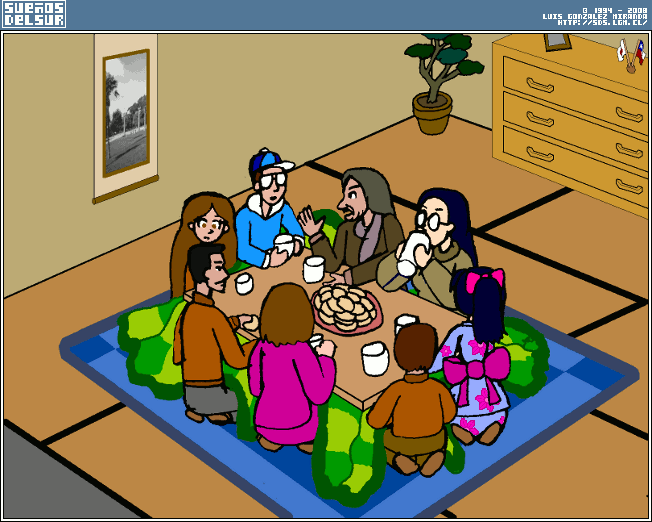#203: A bit of family history - 2010-11-22
Upon entering the house, the children immediately remembered the photographs they had seen at the family album many years ago. Photographs of the travel they did ten years earlier to that very house. Pedro, in particular, had no memory from such travel, he only knew it from what he saw in these photos; in 1985, Pedro was just a newborn, so for him, technically, this was his first visit to the grandparents' house in Japan.
The house of Atsuko Nishida and Carlos Martínez, unlike other dwellings at the neighbourhood, combined traditional japanese elements with a design not quite distinct from that of many social housing projects in Chile. Of note is the total absence in this house of objects related with buddhism and shintoism, being replaced by copies of “The last supper” by Da Vinci, and “The madonnina” (or “The madonna of the streets”) by Roberto Ferruzzi.
On the way there, Juan told his children, again, the story of his parents and why they didn't live in Chile. Atsuko and Carlos had their religious wedding in 1957, and during the sixties they lived in Concepción, Chile. There they brought up their sons Juan and Miguel, and lived until early 1975, year in which they were awarded the “Pinochet scholarship” and they had to migrate to Japan.
“ That day I was in Talca, at the house of Clara's parents. I already had finished secondary school, and thought of studying at university. Clara's father demanded several conditions before allowing me to date his daughter, so I spent a good part of that summer working for him. ”
“ That was the second day of February, and I was thinking of going back home. Then, a telegram was sent to the house, with the following message: ”
DO RMIRNKRIGNI KOBChUEIC RIVSON SN 8178...
Upon seeing the message, I knew it was from my parents, but as I didn't have deciphered it yet, my first reaction was to take a bus to my house in Concepción. The house no longer existed; at its place, there was a warehouse.
In order to decode that message, you have to use the Japanese morse code; the morse codes for most letters coincided with a syllable from the japanese sillabary, excepting the codes «RM» (テ), «RN» (ン), «RI» (オ) y «GN» (シ), which were the same except by a spacing between letters, and the codes «DO» y «SN», which marked the start and end of the message. El code «Ch» was a single letter in morse code, and in japanese morse code it corresponded to the syllable «コ». The numbers at the end were a phone number in Kōbe. ”
“ The result of decyphering that message is the following haiku: «デンワオジ ワレハコウベニ オクラレタ» («電話叔父 我は神戸に 送られた»), which can be translated as «Phone the uncle, we to Kōbe, were sent». A full year had to pass before I could decypher that message, but I'll never be able to forget it. ”

Now they were inside, and a long chat started, in which they talked with length about what happened at their lifes during the last ten years.
Carlos Martínez was now a marine biologist with 20 years of experience at southern Japan's marine wildlife, and he often travelled to peripheral islands in order to make studies out in the field, mainly about benthic invertebrate organisms. His wife Atsuko is middle and high school teacher, she teaches Biology and Chemistry; her school only suffered minor damage, and its gym is being used as shelter; the school returned to classes in January 23.
The children were the most important subject that Juan and Clara talked about, mostly their school performances and the personality they all had developed. Little did Juan want to talk about his irregular performance at work, but his mother knew him as a lazy man since quite a while.
Dinner consisted in kaiten'yaki (回転焼き), a dessert made of batter that, in this case, had a surprise filling; adzuki bean paste, confectioners' cream (custard with starch; kaiten'yaki is usually filled with vanilla custard alone), molten cheese and chocolate cream. And milk to drink.
